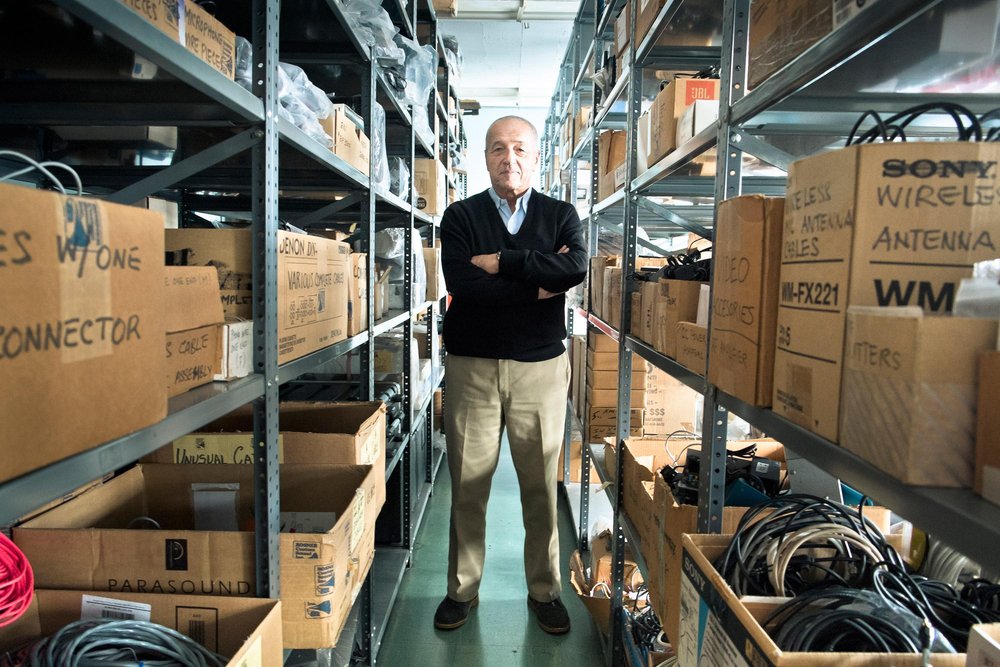
Klipsch: No Bullshit
An audiophile goes to Arkansas to discover the magic behind the legendary speaker celebrating its 70th anniversary
Cruising down U.S. Highway 278, Jim Hunter identifies the vast green field rolling past the window of his Chevy pickup truck as the old Southwest Proving Grounds. During World War II, the SPG was a testing site for artillery shells and air bombs, the explosions of which lit up the overhead skies day and night. It was also the site where Paul W. Klipsch, a Lieutenant Colonel second-in-command of 6,000 troops, refined his corner loudspeaker design, which would later be named the Klipschorn.
Hunter, an engineer who worked alongside Klipsch for the last three decades of his life, points out a massive airplane hangar at the far end of the grounds. “It was in that hangar that Paul brought the original Klipschorn to the dance at the end of the war.” It seems the Klipschorn has never been a stranger to a party.
I had travelled nearly 5,000 miles to Hope, Arkansas, for the annual Klipsch Pilgrimage, where enthusiasts gather to celebrate the late Klipsch’s loudspeakers and legacy with music, moonshine and barbeque. These Klipsch devotees range from a Missouri metal goddess and Texarkana music specialist to a local schoolteacher and urbanite dance music diva (myself). It’s a random assortment of men and women, an eclectic bunch that signifies the irreverent and eccentric personality of the pioneering engineer who, with over 20 patents in audio, geophysics and ballistics, liked to quip, “A physicist is someone who knows what’s wrong with a doorbell, but can’t fix it.”

It was through another maverick that I discovered the Klipschorn, the three-way horn speaker that has been in continuous production for 70 years, longer than any other loudspeaker in commercial production. It is fitting that the maverick of whom I speak had himself hosted a party for nearly 50 years, a party that is considered to be the genesis of modern-day dance clubs and also inspired my personal life course change from the time of my original visit 25 years ago.
When I first entered David Mancuso
The dance floor was dotted with ramshackle props including a Buddha and a Christmas tree, and was surrounded by seven columns made up of ten great big wooden loudspeakers, the bottom bass units of which sat on the floor wedged into “false corners,” and the upper components lifted high above so they could beam the mid and high frequencies down over the dancers’ heads. They were like mystical alien towers that emitted a beautiful and otherworldly language. Not only did I hear music new to my ears such as Dexter Wansel’s “Life on Mars” and Code 718’s “Equinox,” but I also discovered a new way of listening.
David Mancuso had discovered this new way of listening in the mid-’60s when he was sitting in his friend Jimmy Miller’s Brooklyn Heights apartment. “He had music gently playing in the background and I finally had to ask, ‘What kind of speakers do you have? What is going on?’” recalls Mancuso. “I was an audiophile for many years before that, but I finally heard something that really got my ear. He said they were Klipschorns.”
Watch a 2016 documentary about soundsystem designer Alex Rosner here
Soon after, David bought two Klipschorns from soundsystem designer Richard Long (also a Klipsch enthusiast) and moved them into his first loft space at 647 Broadway. He recalled, “I was very sensitive that the speakers would have the right environment so I configured the room so that they fit in properly.” Around 1970, the time when he launched his “rent parties” on a weekly basis, he wanted to cover his 19.5 x 37-foot space with sound, so he bought two Klipsch Cornwalls from yet another sound designer, Alex Rosner, to fill in the sonic gaps and the result he remembers “was very intense. People would visit my loft space and everybody would like the way it would sound. It was extraordinary.”
I asked him what he liked about the sound reproduced by Klipsch speakers and he replied, “I could listen to music effortlessly. I didn’t have to listen to the soundsystem; I could get right into the music.” He then elaborated, “I always pursued listening to something that was close to the original moment and Klipsch did that as they are efficient – it totally made sense.”
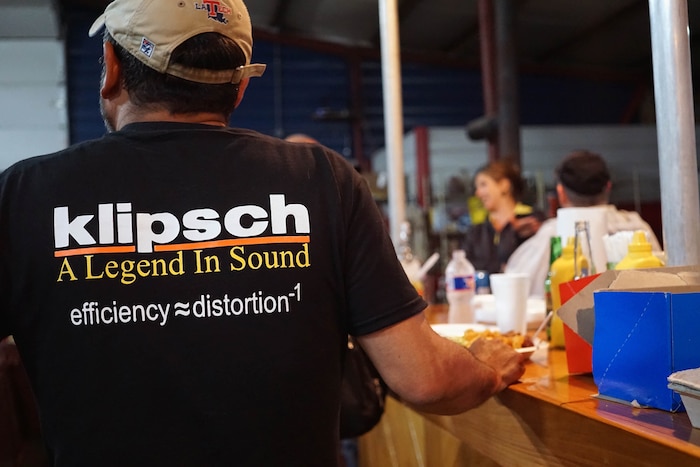
Most loudspeakers are in the 85-to-95 dB sensitivity range... The Klipschorn’s is 105 dB, which means very little power is needed to make a big sound.
If Paul Klipsch had been into Eastern philosophy in another life, his mantra would have been “high efficiency.” The efficiency of a loudspeaker is related to its sensitivity rating or the measurement of the speaker’s sound output when it is powered by one watt from an amplifier. The sound is measured one meter in front of the loudspeaker and expressed in decibels, or dB. Most loudspeakers are in the 85-to-95 dB sensitivity range, and some loudspeakers are so inefficient that the manufacturers do not even state their sensitivity rating.
Only about one percent of the electrical energy sent to a typical loudspeaker is converted into acoustic energy or sound. The rest of the electrical energy is converted into heat and that can eventually degrade a loudspeaker’s components like the voice coil and magnet assembly. The Klipschorn’s sensitivity is 105 dB, which means very little power is needed to make a big sound, hence the Klipsch motto, “Pissing off the neighbors since 1946.”
The Klipschorn is a fully horn-loaded three-way speaker, which means it houses three different speaker units each with their own diaphragm and horn in three different frequency ranges: high, mid and low. Splitting up the frequencies in this way ensures less frequency modulation distortion. In order to work properly, the Klipschorn must be wedged tightly into a corner. “It takes advantage of the acoustic properties of the room and it allows the room to be a part of the speaker,” says Jim Hunter. “The two walls become part of the horn and you’re actually in the speaker.” The way I like to think of it is being “in” the music.
They make miniature tubes and miniature loudspeakers, but they have yet to come up with a miniature 32-foot wavelength.
Paul Klipsch designed the Klipschorn because he wanted to recreate the sound of a symphony in the living room, the sound that one could hear in a concert hall or movie theater. According to Hunter, “The performance of the gigantic movie theater speakers of the time is what Paul wanted to duplicate in a compact speaker for the house, a speaker you could get through the front door.”
Low frequencies have longer sound waves that require bigger horns. So Klipsch patented a folded-horn 15-inch woofer that gave it the dynamic range he wanted on the bottom end. As I sit here looking at the two Klipschorns that dominate my small cottage living room, I am bemused that these speakers were ever considered “compact,” but when we consider the size of the speakers whose dynamic range Paul was trying to replicate, the Klipschorns are dainty little things. And as Paul watched speaker designs become smaller and smaller, he retorted, “They make miniature tubes and miniature loudspeakers, but they have yet to come up with a miniature 32-foot wavelength.”
This quip is known as a “Klipschism,” and Paul had plenty of them. One of his most famous was a simple slogan: “No Bullshit.” “Paul got into the audio business before there was a business and he was a scientist without a doubt,” says Hunter. “Everybody else was getting into the business trying to make a buck with bullshit-type ideas. There were hundreds of speaker companies that he watched come and go. In the ’60s, he was reading a consumer audio magazine that had an advert for a competing loudspeaker company which he felt was making false claims, and he threw it up in the air and screamed, ‘Bullshit!’” The “No Bullshit” slogan was then printed up onto badges that Klipsch handed out at Institute of Electrical and Electronics Engineers conferences during the reading of technical audio papers.
As a close friend of David Mancuso, I can say with some experience that he is a “No Bullshit” kind of guy in a similar fashion to Paul. When it comes to the world of nightclubs, David has remained an outsider and finds most of the professional DJ and club business made up of smoke and mirrors. This is much like Paul’s attitude within the audio business and demonstrated by another great “Klipschism”: “My theories on audio production will only be proven wrong when the laws of physics change.”
Both Paul and David share the qualities of being pragmatic and idealistic. David put together his system decades ago and aside from a few tweaks, it has basically stayed the same. He continuously reminds me not to “chase the sound cloud” and “if it ain’t broke, don’t fix it.” Along with his Koetsu cartridges and Mark Levinson electronics, the Klipschorn has been a mainstay in the Loft system as they fundamentally work, especially in a large room, as they “throw” or “project” and fill the space with sound.
I mentioned to David that I felt the Klipschorn was an honest speaker. “Totally,” he says, “and that reflects on the person who built them. It replies to whatever you feed it. If you feed it correctly it will respond correctly.” David has always endeavoured to “search for the truth” and recalled a moment when “I was listening to Nina Simone and it sounded like she was sitting in the room. I could sonically see her.”
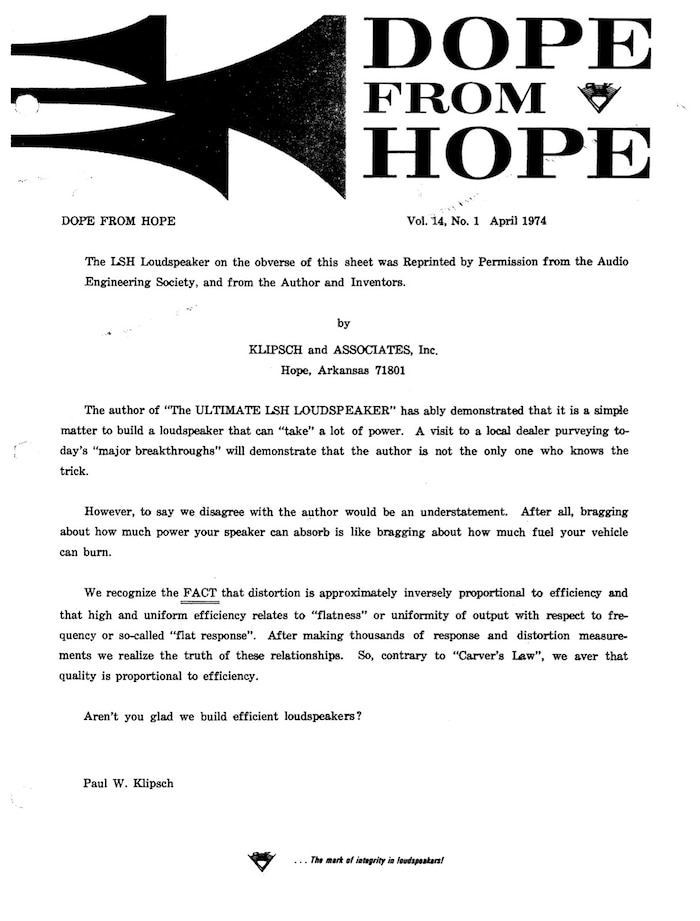
Once he was turned onto Klipsch, David dug deeper and sought out Dope from Hope, a collection of audio papers written by Klipsch (and to which Hunter, now the official Klipsch historian, is continually digging up “missing” volumes). He returned to the papers time and again, especially when he had a new space and needed to change the set up, which in some cases resulted in pulling in the Klipschorns away from the wall for near-field listening.
David wanted to share what he had learned: “I kept Dope from Hope in my drawer and read it many times. I made copies and gave them out.” I was one of those people that David encouraged, and after years of patient prodding, he finally succeeded in pushing me into high-end audio. He is the reason why I can now talk about frequency modulation distortion whilst cooking a family dinner.
Shortly after I had pulled up my roots from New York and replanted in London, David and I produced a couple of Loft compilations on Nuphonic. I had hoped there would be a way to bring a similar Loft experience to London and with David’s participation and support, I joined forces with Tim Lawrence, author of Love Saves the Day, and our friend Dr. Jeremy Gilbert, and we bought our own soundsystem for our Lucky Cloud Loft parties in London. Six Klipschorns were included in our shopping spree, and of course, they needed a home when not being used for our quarterly parties, so two took up residence at our house.
My husband and I had a six-month-old baby and we had just moved into the house, so all I had at hand was my old Sony CD Walkman and a very basic integrated amplifier. But I remember the moment when I first played music through the Klipschorns and our daughter just looked up at me as if she had witnessed a miracle. It was a beautiful moment.
David and I have both “musically hosted” many different Loft and Loft-inspired parties around the world. While playing records at these parties, sometimes dancers come up and ask me which song I am playing. I hand over the record so they can have a look and often they say, “I have this record but it has never sounded like this!” At our last Lucky Cloud party, a blind friend was convinced I was playing a Prince remix and not the original.
The same kind of enlightenment would happen when people came over to our house and when we would park ourselves in between the speakers and play an album, friends would comment, “I never heard this album in this way.” That is one of the reasons I started Classic Album Sundays, as I felt it was important to share that experience. But it wasn’t easy, and when we were lugging two Klipschorns up a narrow staircase to the function room of my friend’s pub to inaugurate the first event, I wondered whether I had truly gone mad.

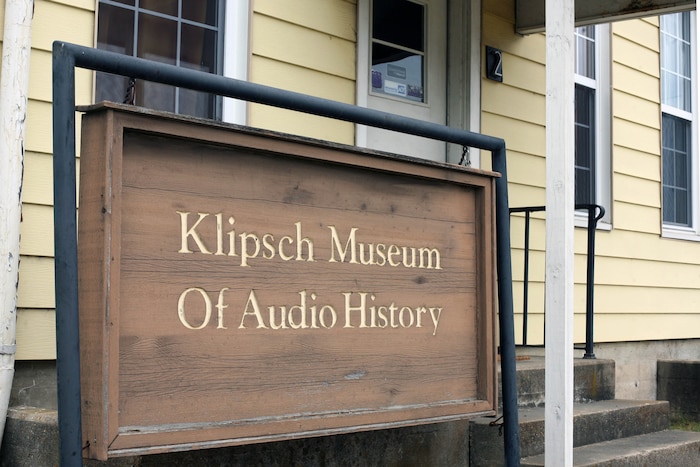
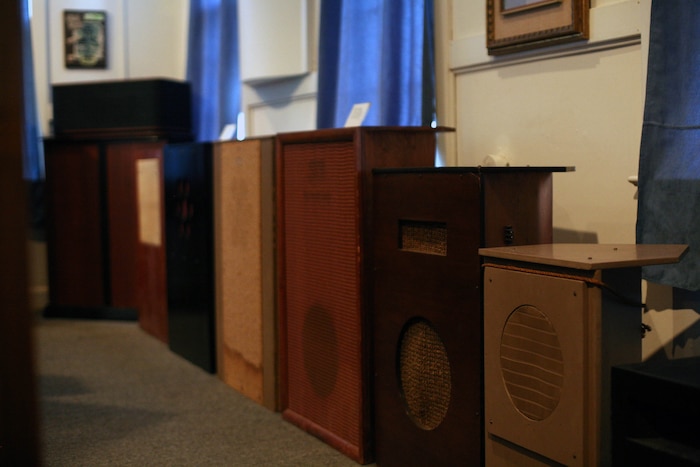
I’m not the only one who is a bit nutty. I was amongst numerous Klipsch devotees who set off in the middle of the night to travel 15 hours to a dry county in the middle of Arkansas for the annual Klipsch Pilgrimage. It was a real hoot chowing down peach cobbler and talking with people from so many different backgrounds who were united by the fact they all had a thing for music heard through Klipsch’s loudspeakers.
In addition to learning more about the speakers and their heritage, we also believed the pilgrimage would help us understand more about the man himself. Paul incorporated Klipsch and Associates in 1946, and a couple of years later he hired his first employee and took over the former telephone exchange for the Southwest Proving Grounds, where they built Klipschorns in the basement. Today this small, modest building houses the Klipsch Museum of Audio History and features an array of significant artefacts, including early Klipschorns and Paul’s other loudspeakers: La Scalas, Heresys and Cornwalls.
But Paul also believed in crediting the audio pioneers who came before him, so the collection also includes many products by Bell Labs, whom Paul adored, including a Western Electric Loudspeaking Telephone (an early loudspeaker), and the museum also features Edison phonographs and one of the Klipschorn’s competitors: a Voigt corner-horn speaker from England. Paul paid tribute to the audio “greats” and was admired himself by many of them in kind. Hunter revealed his fans included “Edwin Armstrong, considered by some to be the greatest electrical inventor of the 20th century for science, and Arthur Fiedler from the art world. And that’s what audio is all about: art and science, and he had respect from the tops of both.”
After checking out the Audio Museum, we crossed the street to the massive plant where the Klipsch Heritage loudspeakers are still assembled by hand.

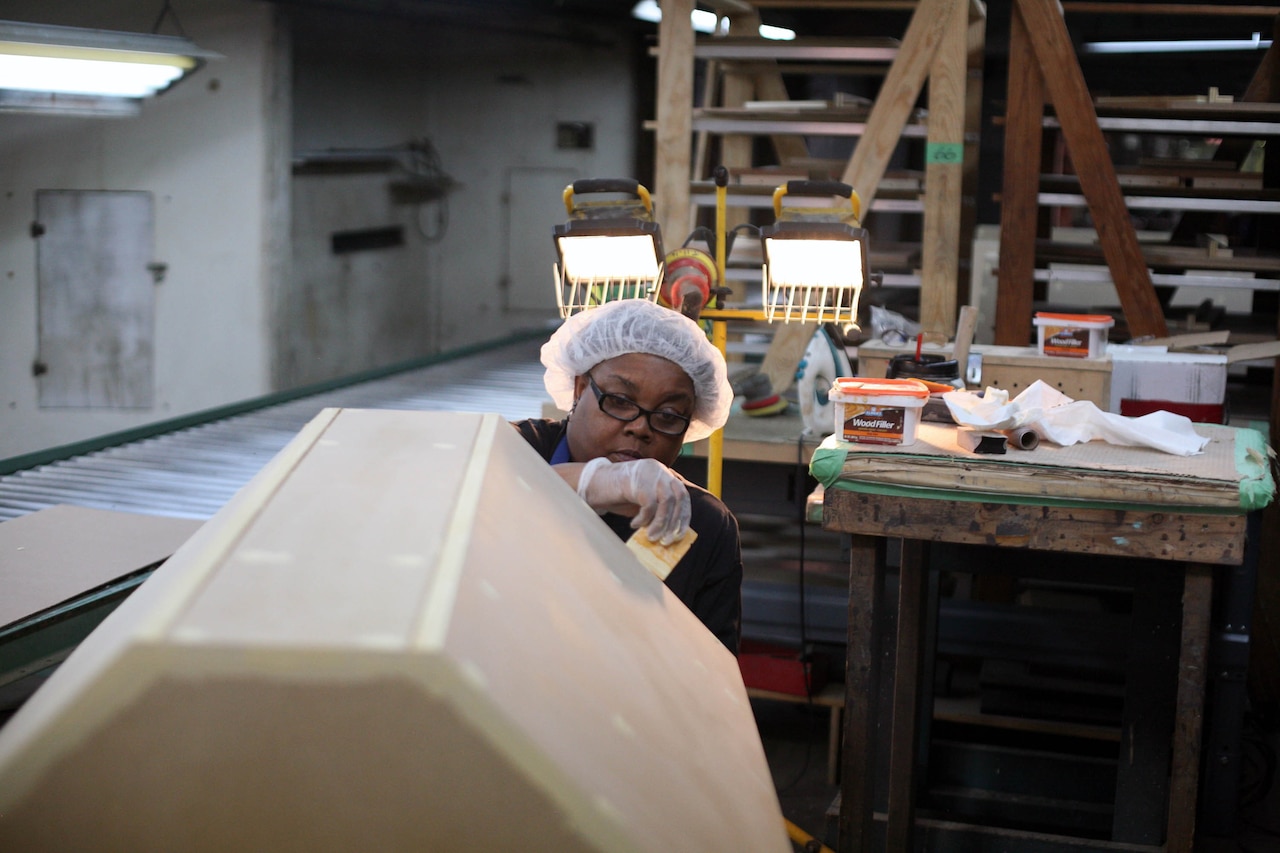
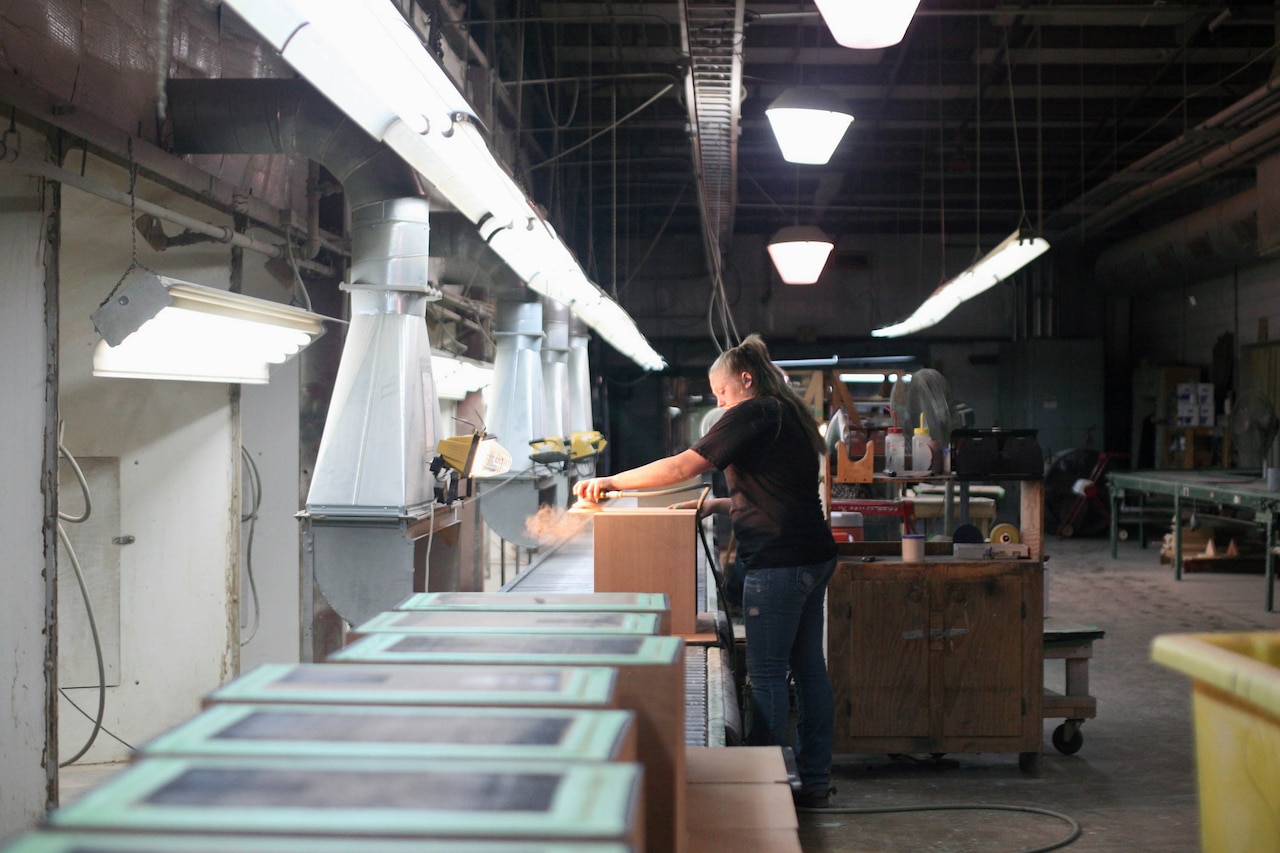
One of my favourite parts of the tour was the visit to the anechoic chamber that Paul and Jim Hunter built together. It was and is still used to test out the loudspeakers in an acoustically sterile environment. The chamber also looks handmade and features a little sign that says “Chuck Retired Here,” Chuck being a portly man who fell into the chamber’s floor and had to be pulled out by the fire department.


And of course, the pilgrims were treated to sound demonstrations of different configurations of Klipsch speakers. Amid the fire ants in the yard behind the plant’s offices and cafeteria, we were able to witness an incredibly kick-ass cinema speaker setup complete with subwoofer horns: the monster KPT Cinema Grandeur.
During another one of the weekend’s demos, I sat down next to Barb, who had travelled from Pensacola, Florida. As we kicked back to listen to The Eagles, Barb turned to me and whispered, “Through the Klipschorns I can hear Don Henley’s voice. On other speaker systems, I only hear a CD of Don Henley’s voice.”
She really hit the nail on the head. Some loudspeaker systems produce a hyper-real representation of the music where it sounds overly enhanced or Disney-fied. It can be overly sharp and sometimes this can just be too much. It’s an overload. I have also read that women may have a greater sensitivity to high frequencies and we often find some hi-fi set ups overly piercing. I don’t have the science to back this up and it’s just a theory, but I know many women share this experience (or maybe we’re just good listeners).
The Klipschorn, on the other hand, sounds musical. David Mancuso even calls it a musical instrument and said, “If you really love music, you probably will love a Klipschorn.” And that’s really what it is all about, experiencing music in a deeply emotional way. Klipsch felt this should be the aim of all audio equipment, not just “hi-fi,” a term that he didn’t regard too kindly. In the great man’s own words, “There is no such thing as ‘high fidelity.’ Either you’ve got fidelity or you’ve got infidelity.” No bullshit.
Colleen ‘Cosmo’ Murphy is the founder of Classic Album Sundays and a musical host at The Loft and the Lucky Cloud Loft Party.
Header image © Stacey Svendsen

